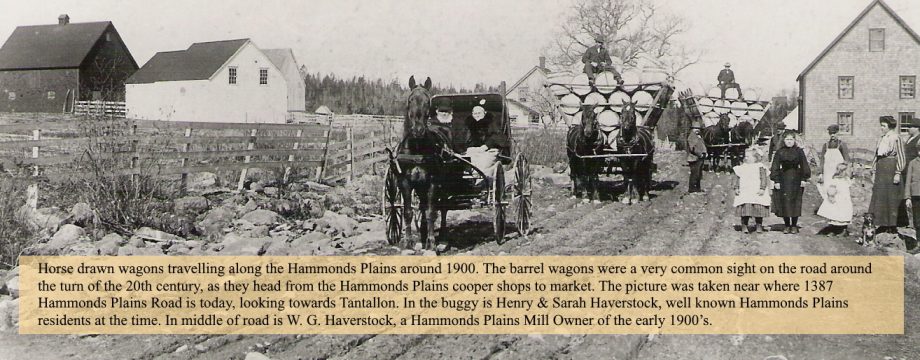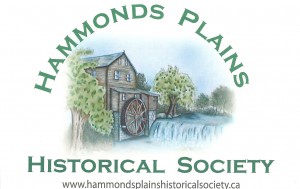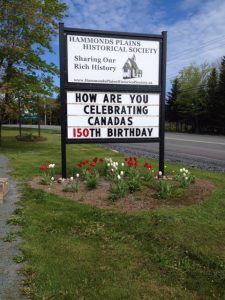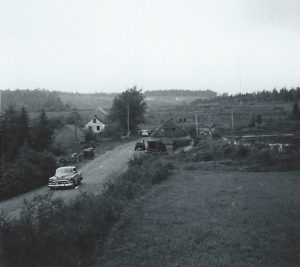Hammonds Plains History – A Look Back
For hundreds of years before the founding of Halifax, the lands encompassing the Hammonds Plains area were occupied by a small group of Mi’Kmaq First Nations peoples, who used the region as their traditional residence and hunting grounds. Winter encampments were located in the area of Pockwock Lake, with summer treks to Bedford Basin to set up summer camp a yearly routi
By the mid 1700’s, with the Treaty of Utrecht (between England and France) and the founding of Halifax, the English had laid claim to the area. By this time, many of the local Mi’ Kmaq had succumb to European diseases and the local population had been greatly reduced.
To sustain the emerging English colony, the governing body of Nova Scotia issued numerous land grants to subjects loyal to the British crown. One such land grant was the Hammonds Plains grant issued in 1786 to 43 land owners, all who had business interests in Halifax. The original grant consisted of 8230 acres, with one thousand additional acres reserved for the King’s Woods – land used for lumber to make masts for English ships. A water lot on Bedford Basin was also part of the grant. The grant was named by the new landowners after Sir Andrew Snape Hamond (the Lieutenant-Governor of Nova Scotia from 1781-1782).
Sir Andrew Snape Hamond
The land was of extreme value to the original land owners as it contained virgin forests, thus offering huge stands of high quality lumber. Many of the land owners had the forests cut on their lands and sold the trees to the Halifax market (transported to Bedford Basin via horse or by way of the Nine Mile River and then sent to Halifax via the basin).
Grantees were supposed to clear land, erect dwellings and keep cattle as a condition of the grant, along with creating a road. Few of the original grantees however actually lived on the lands, but they did put some settlers on some of the grants. As the result, a number of the grants reverted back to the government. By 1791, 15 settlers and families were listed as permanent residents. A road was created through the grants that connected them to the nearest origin of settlement which was a small cluster of homes in an area known as Nine Mile River (near the Paper Mill area in Bedford).
Most of the original grants were sold off during the early 1800’s without homes ever being built on them. During this time, a number of well to do families (mostly from the Chester /Lunenburg area) bought up the lots and started to establish a permanent settlement. The most prominent families who arrived during this time became known as the founding fathers, and an active village quickly developed. A small pocket of settlers set up shop on the road that headed towards St. Margaret’s Bay and their section within the Hammond Plains boundary became known as Yankeetown.
The War of 1812 between England and the US placed Halifax as a strategic military center making it Britain’s main military center on the east coast of North America. After the war ended, the Nova Scotia Governor welcomed many British loyalists to the colony with the promise of land grants. One of these groups were the Chesapeake Blacks from the Virginia area of the US. Most of these individuals had escaped (or in some cases, were stolen) from slavery to fight for the British against the Americans in the war. There was a promise made that if the former slaves would take up arms against the U. S., then they would be granted land at the end of the war in British Territory. One of the areas chosen for this were the lands directly north of the village of Hammonds Plains. A group of 500 refugees moved to this area in 1815 and began carving out a community which became known as Upper Hammonds Plains (although it wasn’t officially named as such until 1946). At the time, the new community was thought to be part of a new major connecting road running from Halifax to Annapolis Royal (called the Annapolis Road). The Chesapeake Blacks assumed that this would make the site very desirable. This land had previously been granted to white settlers; however since they had not used the land or made the necessary improvements the lands were expropriated by the crown and used for the settlement for the Chesapeake Blacks. Part of the grant was the provision for a schoolhouse and a small house for a schoolmaster to be built in the community. The Chesapeake Black settlers had to overcome difficult conditions (poor land for farming, disease, poverty, systemic racism) to create a self-reliant community and the population of the settlement took a major hit.
The plan for a new Annapolis Road also caused the governor to sell land grants to establish new hamlets north of the Upper Hammonds Plains settlement. The new hamlets were located near Wright’s and Big Indian Lakes. Wellington (1816) was the name of the grants given to a group of English discharged soldiers, while Kemptown(1818) was the name given to grants given to a group of Irish immigrants. Within a short period of time the area became known as Kemptown, with the Wellington name disappearing, mostly as the result of the original Wellington grantees moving away due to extreme winters. The area however did develop into an autonomous lumbering community during the 1800’s, with several mills in the area. It even had a small school. However, a major fire destroyed much of the community in the late 1860’s and many of the residents chose to move away. By the 1920’s the community had dwindled to a few homes and to-day no longer exists.
The end of the dream to becoming a prosperous area along the Annapolis Road came to an end during the 1830’s when the English governor abandoned the road project. However, the ensuing years saw the Hammonds Plains area become prosperous in another way as it became a prominent lumbering region, with the creation of mills on the many lakes. Shops were established along the road to make wooden products from the mills such as barrels, shooks and wooden boxes. Copper Shops soon dotted the landscape.
The 1800’s also saw the establishment of schools, churches (3 Baptist, Anglican, and Catholic), inns, blacksmith shops, a Temperance Hall and small general stores within the communities of Hammonds Plains, Upper Hammonds Plains and Kemptown. The 1861 census listed 770 individuals living in the area.
Prominent Hammonds Plains family names during the 1800’s included: Bezanson, Eisenhauer, Frizzel, Haverstock, Hays, Johnson, Mason, Melvin, Pace, Romans, Smith, Thomas and Thomson. In Upper Hammonds Plains prominent names included: Allison, Anderson, David, Emmerson, Hamilton, Jackson, Marsman and Whiley. In Kemptown significant names included Davidson, Greene, Langille, Little and Wright.
The Hammonds Plains road was upgraded during the 1800’s, going from a horse trail to one where wagons could drive over. In 1831, a road running from Sackville was added to join on to the Hammonds Plains Road. This became known as the Lucasville Road. Farming and forestry became the chief industries of the community and transportation evolved to larger and more dependable wagons. Some of the larger mills moved from water power to use of turbines in the late 1800’s.
In 1880 the Hammonds Plains area becomes part of the newly incorporated Halifax County and was given its own seat on the county electoral council. Norman Hays served as the first Hammonds Plains councilor.
By the end of the 19th century Hammonds Plains was a thriving independent community, although Upper Hammonds Plains and Kemptown still had economic struggles. The community saw on a daily basis, wagons of barrels and boxes heading to market in Halifax. At the peak of the barrel industry there were approximately 30 cooper shops along the roads
in the community. During the late 1880’s there was an actual out migration with numerous young people leaving to go to the US to earn higher wages as coopers.
The dawning of the 20th century brought wide spread changes. Phones came to the community in 1902, with the community creating its own phone company, the Hammonds Plains Phone Company, originally consisting of three phones. A new community hall was built in 1912 in Lower Hammonds Plains. Cars were introduced to the community just before the First World War, with the first residents owning cars by the early 1920’s. Power lines were put through the community in 1932, bringing electricity to the area. The era of oil lambs for light had come to an end. Kemptown was no more by the 1920’s.
The first half of the century saw the wooden box and barrel industry driving the economic engine for the community. At least 15 saw mills were operating in the area. Both Hammonds Plains and Upper Hammonds Plains were tightly knit during this time with many church activities, community suppers, box socials, the Labour Day picnic and turkey shoots becoming popular social events. Hammonds Plains answered the call to serve their country during World War 1, as at least 17 residents joined the services to aid in the war effort. Christopher Haverstock becomes the only resident to die serving his/her country, as the result of WW1.
The great depression of the 1930’s started the decline of the golden age of the forest industry in Hammonds Plains. While the mills ran at a full speed ahead pace during the years leading up to and including World War 11, there were less mills in operations compared to earlier in the 20th century. The Second World War saw the community act as a training ground for Canadian soldiers. During the war, the IODE women’s group was very instrumental in providing donated supplies to our overseas soldiers. Approximately 22 residents sign up for military deployment. Throughout the war, residents and businesses alike lived with shortages of items such as rubber, steel, tin, leather and gas.
During the mid-1900’s the Forester’s Community Hall was the center for the community, hosting social events such as card games, movies, suppers, concerts, and fund raisers. Recreation and sport always played had a big role in the community. Hunting and fishing was very widespread since the beginning days, and skating was an activity enjoyed by many on the lakes and on one of the community rinks. Baseball was a popular summer sport, with the community having its own organized team during the early part of the 20th century. A big addition to the community during the 1940’s was the building of a community outdoor rink near the intersection of the Hammonds Plains and Lucasville roads. Also during the mid-1900’s new schools opened in both Upper and Lower Hammonds Plains. A Fire Protection Group was formed in the community during this time as well, which ultimately led to the formation of Hammonds Plains Fire Department in the 1960’s.
After the Second World War, the forestry industry in Hammonds Plains truly started to decline, with declining demand for wood products, as new technologies and decreasing fish stocks became the new reality. Mills and Cooper Shops gradually closed with only a handful left by the 1970’s. During this time, many of the young folks in the community used the improved methods of transportation to seek employment in Halifax. Hammonds Plains feels the effects of the cold war with the Department of National Defense building communication transmitting and receiving towers in the community in 1953 to provide warning in case of a nuclear attack.
With the decline in the forest trade, so called new age businesses start to pop up with a modern gas station, grocery store, car parts yards, golf course and trucking/excavating companies all being introduced during the 1950-60’s. By this time most of the residents had turned to working in Halifax, as increased mobility becomes the new normal.
A colossal change to the community came in 1957, when the Hammonds Plains road was widen and paved. This opened up the road to increased traffic and new sub-divisions soon followed to become the face of the community, the first being Uplands Park started in 1961.
Fire Departments were created in both Upper and Lower Hammonds Plains during the 1960’s. The Upper Hammonds Plains Fire Department served as the only all black department in Canada, until it was retired in 2013. In 1967, the Hammonds Plains Consolidated School was opened, taking in all the students of the Hammonds Plains area, thus closing the outdated Hammonds Plains and Upper Hammonds Plains Schools.
The 1970’s saw significant cosmetic change in the community with new businesses such as a race car track, camp ground, excavation companies, food places, and gas stations replacing the traditional mill related commercial buildings. Highland Park becomes the second major subdivision to enter the community leading to an unprecedented period of population growth. Pockwock Lake is taken over by the city in 1973 as it transfers to being the water source for Halifax, ending the community’s long connection with the lake as a recreational and forestry haven. The Forester’s Community Hall also ends its career during the 1970’s as the old hall was closed for community events.
The late 20th century brought tremendous growth to the community with the establishment of new subdivisions, such as Highland Park, Kingswood, Glen Arbor, Blue Mountain, White Hills, Maplewood and Waterstone. The growth brought with it increased traffic, new restaurants, a world class golf course at Glen Arbour and community baseball fields. Two new schools opened as Madeline Symonds Middle School and Kingswood Elementary were added to the community education landscape.
Recent years have seen continued growth with the creation of further sub-divisions at Voyager Lakes, Kingswood West and North and Perry Ponds. The highway is now dotted with traffic lights at many of the intersections, with several adjacent strip malls along the side of the road. In recent years the road has added active transportation lanes. In 2005 Emmanuel Baptist Church saw a significant expansion, making it one of the largest churches in HRM. Hammonds Plains also has added two entertainment centers on the lands owned by first nation groups in the community. Many folks from outside the community also visit the area for recreation uses as Hatfield Farms and the Atlantic Splash Pad offer unique opportunities for young and old alike.
Today the Hammonds Plains area is considered a prosperous suburban community that continues to change and evolve.
![]()









